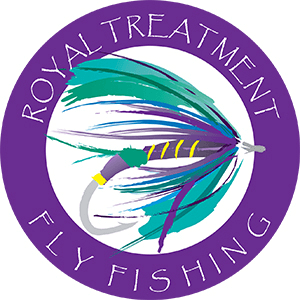Rowell's Shrimpton

The Shrimpton was born from me wanting a smaller "intruderish" style fly for fishing in the winter and spring. I felt that the large, heavy intruders I had been tying were often difficult for my clients to cast and fish. Also, a slightly smaller fly that still had a good profile and lots of movement might be a little more desirable to steelhead in clearer water. The first time I saw the fly swimming in the current of a favorite coastal river, I remember saying to my buddy Mike, "Hey, come check this out; it looks like a little prawn or something." He came over to see and agreed. The eyes towards the rear of the fly and the barring on the wing made it look very shrimpy and alive!
That day we started calling it the Shrimpton and the name stuck. Since then, it has been a go-to confidence fly anytime I'm guiding or fishing with a sink tip. The fly is easy to cast because of its size and lightweight design, yet it still has enough of a profile to be seen in high dirty water and elicit an aggressive strike.
I like to fish the pink one when the river is up and green, or I think there are ocean fresh fish around. I turn to the red one later in the season or when the river is low and clear, especially on a bright sunny day. Although originally designed for winter steelheading, the Shrimpton has become a great sink tip fly while fishing for summer steelhead. I like to rig the fly with a size 2 octopus hook hanging just out of the back of the tube, but it can also be rigged with a straight-eye hook sucked just up into the junction tubing. Nick Rowell
Material List:
Tube: Pro micro tube, clear
Weight: Pro Raw weight (tungsten) small, followed by medium soft sonic disc, clear
Junction tube: Pro Hookguide, large clear
Thread: 6/0 orange
Dubbing: Angel hair, Uv Pearl
Rear Hackle: Lady Amherst tail fibers, light pink
Tail: Marble fox, cream, mostly guard hairs
Eyes: Golden pheasant tippets, natural
Body: Pearl mylar tinsel, large
Front hackle 1: Lady Amherst head, Orange
Front hackle 2: Marabou, two pieces tied in tip first, one shell pink, one white
Front hackle 3: Schlappen, pink
Front wing: Matched hackle tips, grizzly dyed orange
Tying Instructions:
Step 1: Start the thread at the back of the tube and form a dubbing loop about 7 to 8 cm long, wax loop
Step 2: Put Ice Dub in loop (should take up about the top 2.5 to 3 cm of loop). Then put Amherst in loop (about 15 to 18 3.5 cm long fibers clipped off quill and spread about 2 cm, use a bodkin to separate fibers so they don’t bind together when spun). Spin loop so dubbing and Amherst is locked in and flared out like a hackle.
Step 3: Begin wrapping loop, form a ball of angora at rear of tube. Sweep dubbing back as you wrap. Continue wrapping Amherst in front of angora, again sweep back fibers as you wrap.
Step 4: Tie in marble fox tail on top of tube, should be about 5 cm long. Tips of tail should extend about 1 to 1.5 cm past Amherst.
Step 5: Tie in one 1.5 cm long golden pheasant tippet on each side of the tube right along the side of the Amherst. Tie in with back of feather facing out so they flare out.
Step 6: Tie in pearl mylar and wrap forward, leave about 1 cm of bare tube in front of mylar. Tie off and whip finish. Put on pro tungsten weight and soft sonic disc, and push it up against mylar.
Step 7: Start thread in front of cone. Tie in Lady Amherst head feather tip first, wrap hackle, about 3 turns. Fibers should be about 3.5 cm long.
Step 8: Tie in two pieces of marabou tip first. Wrap hackle, 3 turns.
Step 9: Tie in Schlappen tip first, wrap hackle, about 3 to 4 turns. Fibers should be about 2 to 2.5 cm long.
Step 10: Tie in matched hackle tip wings on top of fly. Wings should be about 5.5 cm long and should extend to about 2 cm of tip of tail. Whip finish




